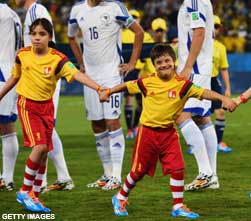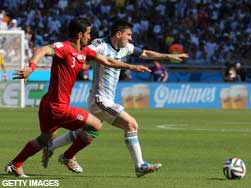The '14 FIFA World Cup is well into its second week, and THE DAILY polled five soccer marketers about their early thoughts surrounding the tournament. Of particular focus was the evolving debate over the necessity of securing official sponsorships as opposed to ambushing, as well as which companies have stood out for their activating prowess both on the ground in Brazil and through various forms of media. Below are responses from Gilt Edge Soccer Marketing Founder John Guppy, who is currently on the ground in Brazil; Glideslope President Dave Mingey, who traveled to Brazil but is now back in the U.S.; Octagon Exec VP Derek Aframe; LeadDog Deportes Managing Dir Brad Rothenberg; and GMR Marketing Exec VP Adam Lippard, who is heading to Brazil today.
 |
McDonald's player escort allows kids to walk on the
field prior to the match |
Q: With social media and the Internet opening up so many new, inexpensive ways to market to fans, how important does it remain to be an official FIFA partner and why?
Guppy: The reasons to invest in official sponsorship programs like FIFA extend well beyond the social campaigns and TV spots people tend to talk about. FIFA partners have the ability to craft global business platforms that address everything from direct B2B product integration and supplier relations, to advancing CSR agendas, to unique consumer promotions, experiences, and media. McDonald’s player escort program provides money-can’t-buy experiences for lucky kids from around the world. The install of solar panels on the famous Maracana Stadium helps Yingli Solar advance the agenda for clean renewable energy. Visa commands millions of credit card transactions around World Cup activities. None of these things would be possible without an official partnership with FIFA.
Mingey: Ambush marketing continues to appear much more prevalent at a World Cup than at an Olympic Games. You never see Pepsi around an Olympic Games. Without significant changes in governance, policing or legislation, it’s likely that the value of a well-coordinated ambush marketing campaign will only become more attractive on the World Cup stage.
Aframe: While an official FIFA World Cup partnership is one way to craft that authentic link, there are other means to that end -- the use of brand ambassadors, national or professional team associations, or even creative that effectively links to the cultural relevance of football in Brazil, worldwide, and/or in local markets can give brands that authentic connection to the tournament. Whether companies spend tens of millions of dollars for a direct association or a nominal sum for a brand ambassador, having the relationship is not enough -- it’s what brands do with the IP they have acquired to be authentic and foment desired behavior which makes the difference.
Lippard: To sponsor or not is a tough call, especially given escalating rights fees, media fragmentation, social and the opportunity to work legally around the edges of official rights. That said, I come from an “official rights” perspective. I strongly believe access to the event’s IP and trophy are powerful tools (e.g. Coke’s worldwide Trophy tour, Budweiser stadium pouring rights, Visa acceptance platform, etc.) that help official partners cut through the clutter and differentiate from non-sponsors.
Rothenberg: Social media and the Internet quickly increase the fanbase for soccer in critical markets like the U.S. I don't think this diminishes the value of a FIFA sponsorship. Just the opposite. All this social and real activity around soccer relies on the FIFA World Cup content at its core and there's no replacing the FIFA World Cup games themselves and the value of association.
 |
A-B's promotes its Quilmes brand while Argentina
is playing |
Q: From a marketing and activation perspective, which official FIFA sponsor has stood out in your mind thus far during the World Cup and why?
Guppy: One of the most memorable official sponsor assets has to be the adidas Brazuca ball. Its distinctive design is highly recognizable and seems to be everywhere on the streets, in newspaper coverage, on TV, and surprisingly, also in the back of Spain’s net! I don’t remember feeling the same level of impact from previous adidas official World Cup balls.
Mingey: Coca-Cola has done a great job of connecting their brand values of happiness and togetherness to the World Cup. Their work is especially noticeable at several of Brazil’s domestic airports. ... A-B InBev owns dozens of brands around the world -- I was impressed that they are tailoring sideboards to the national beer brands of the teams that are playing. This is a small detail that many brands would have forgotten. Hublot has also done an excellent job activating their sponsorship with the design of the referee board to resemble their timepieces. This has given the brand an opportunity to show off their watch design and get significant brand exposure, while seamlessly integrating into critical moments of gameplay without intruding on the fan’s experience.
Aframe: I look to see how brands look to capitalize on the scale, scope and rich emotional territory which the FIFA World Cup provides, while remaining authentic to the sport and to their own brand identity and objectives. FIFA World Cup sponsors like A-B InBev and Johnson & Johnson have employed a multi-brand strategy to maximize product relevance to fans by customizing their brand messaging for specific matches, accounting for which markets are most likely to watch in greater numbers. For example, A-B InBev promotes their Quilmes brand when Argentina is playing, and Budweiser for USA matches on the FIFA digital field boards.
Lippard: Visa is leading the charge from the FIFA partner/sponsor perspective for two main reasons. First, they have ensured that mobile is at the heart of their activation, knowing that a mobile device is often the primary way consumers engage with this passion-based content. Building on this passion, Visa has clearly understood that no matter what country you’re cheering for, passion for the game is the uniting force.
Rothenberg: Anybody going to argue that Adriana Lima and Kia isn't the most compelling commercial set? Appealing to our love of "traditional" football as well as our love of beautiful people? It's a very specific target audience (and isn't driving a lot of women to buy Kia), but it's a great series of commercials targeting the blue-collar middle-aged Anglo male. There may be more thoughtful brand messages out there, but that marketing initiative hits me right on target.
Q: From that same marketing/activation perspective, which non-official sponsor has stood out in your mind thus far during the World Cup and why?
Guppy: Several Brazilian companies are taking advantage of the event. Companies like Unimed (healthcare), Vivo (wireless), Gol (airlines) have formed relationships directly with the Brazilian national team and/or iconic players of past and present. They are utilizing these authentic partnerships in combination with powerful "yellow" imagery to make a strong consumer connection.
Mingey: Brazil is a very important market for Volkswagen. Golf has routinely been the best-selling car in Brazil and VW had the second-highest Brazilian market share for new cars in 2013. VW has teamed up with ESPN talent and football personalities to provide co-branded television creative to support the new Golf launch. VW posts their unique “Goooooooolf Celebration Video” to social media after every World Cup goal. Without being an official sponsor, VW has authentically integrated the brand into World Cup celebrations.
Aframe: MasterCard has tapped into its Brazil national team sponsorship to build a strong and targeted platform that links with its broader campaign around Priceless Brazil and Priceless Surprises. The program speaks to both Brazilian citizens and visitors in a way that rewards consumers for card usage at tourist destinations, bars and restaurants, hotels, taxis, cinemas, etc. Brand ambassadors, merchandise, and experiential assets provide the carrots for cardholders to use MasterCard products, and the moments when consumers are "surprised" by a Brazil footballing legend for using MasterCard are leveraged through social media channels. Another strength of the program is that it is designed to have legs and continuity beyond just mid-July.
Lippard: Beats by Dre broke through for me. The work they did with releasing their Game Before the Game spot tying in the world’s best football players, pro athletes (LeBron, Serena), musicians (Lil Wayne), etc. really showed how a brand can create noise around a global platform across sports, pop culture, etc. The most unique ambush activation I’ve seen executed around the 2014 World Cup was executed by Sportsbet, an Australian gambling company in Melbourne. They created a 150-foot-high inflatable replica of Brazil’s Christ the Redeemer Statue adorned in a jersey with the hashtag #KeeptheFaith in support of the Australian team, who arguably had the toughest pairings in the 1st round of the tournament.
Rothenberg: Beats by Dre "The Game Before The Game" hits it on the mark. Not only do we get Neymar and crew -- the most compelling players in the World Cup -- but you get the "pregame" content that seems right on target for all athletes -- from World Cup stars to local community weekend warriors. Again, even older guys like me who think of themselves in past glory connect to this pregame ceremony.





